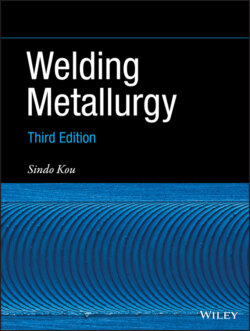Читать книгу Welding Metallurgy - Sindo Kou - Страница 72
2.2.2.1 Rosenthal's Two‐Dimensional Equation
ОглавлениеFigure 2.16 is a schematic sketch showing butt welding of thin sheets. Because of the small thickness of the workpiece, temperature variations in the thickness direction are assumed negligible and heat flow becomes two‐dimensional. Rosenthal [25] derived the following equation for two‐dimensional heat flow during the welding of thin sheets of infinite width:
(2.8)
where
T: temperature
T o: workpiece temperature before welding
k: thermal conductivity
g: workpiece thickness
Q: heat transferred from heat source to workpiece
V: travel speed
α: workpiece thermal diffusivity, namely, k/(ρC), where ρ and C are density and specific heat of workpiece, respectively
K o: modified Bessel function of second kind and zero order [26], as shown in Figure 2.17
r: radial distance from origin, namely, (x 2 + y 2 ) 1/ 2.
Figure 2.16 Two‐dimensional heat flow during welding of thin workpiece.
Figure 2.17 Modified Bessel function of second kind and zero order.
Equation (2.8) can be used to calculate the temperature T(x, y) at any location in the workpiece (x, y) with respect to the moving heat source, for instance, at x = −1 cm and y = 4 cm, as shown in Figure 2.16. The temperatures at other locations along y = 4 cm can also be calculated, and the temperature distribution along y = 4 cm can thus be determined. Table 2.1 lists the thermal properties for some common materials. Properties of more materials can be found elsewhere [27].
Table 2.1 Thermal properties of some common materials.
| Material | Thermal diffusivity α (m2 s−1) | Volume thermal capacity ρC s (Jm−3 K−1) | Thermal conductivity k (Jm−1s−1K−1) | Melting point (K) |
| Aluminum | 8.5 × 10−5 | 2.7 × 106 | 229.0 | 933 |
| Carbon steel | 9.1 × 10−6 | 4.5 × 106 | 41.0 | 1800 |
| Austenitic stainless steel | 5.3 × 10−6 | 4.7 × 106 | 24.9 | 1773 |
| Ti alloy | 9.0 × 10−6 | 3.0 × 106 | 27.0 | 1923 |
| Copper | 9.6 × 10−5 | 4.0 × 106 | 384.0 | 1336 |
